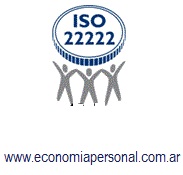What ISO 22222 brings to my business

Paul Richardson, managing director of Concept Financial Planning, talks about what made him apply for ISO 22222, the process involved and what it has brought to his business
Adviser Business Review: Why did you apply for ISO 22222?
Paul Richardson: ISO 22222 is the only certification of its kind available to advisers and I liked the appeal of benchmarking our service and internal processes against the international standard of best practice. There is a huge difference between ISO 22222 and qualifications. Attaining a qualification requires you to study, go into the exam room and that’s that. ISO 22222 takes the process one step further; it is all about applying that technical aspect to your work on a daily basis and delivering the best possible service to clients.
ABR: How long did the application process take and what did it entail?
Richardson: I completed the application within three months, which is hugely exceptional, but I had a good base from which to start. During that time, I underwent a rigorous process of assessment, which included breaking the business down into segments and rebuilding it. Allowing a third party to provide an independent review of our processes taught me a lot about how the business should behave.
Working so closely with Standards International to achieve ISO 22222 was very helpful – the practice management system has changed the way we think about things and we strive to continually improve. It gave us the framework we needed to grow the business, bring on additional staff and have those new employees feel confident about the company they were joining.
ISO 22222 is not designed for an adviser who is happy to stand still; it is all about developing and advancing. It is hard work and takes commitment to achieve, but if you asked me if the whole process was worth it, I would definitely say yes. It was, and continues to be, a very rewarding experience.
ABR: How do you maintain your certification?
Richardson: We obtained the certification in June 2009. Advisers with ISO 22222 are assessed on a yearly basis and in order to maintain the certification, you need to be able to prove yourself over and over again. Every year they come and take an in-depth look at a certain part of the business. While that might sound daunting, if you’re doing the right thing on a daily basis then it shouldn’t be an issue. Maintaining ISO 22222 is about striving for improvement – it’s not a matter of quickly dusting off the manual once a year to see what they will ask. It’s about permanent change and making sure you live and breathe the process year on year.
ABR: How has it affected your business and client relationships?
Richardson: It’s both a personal and professional achievement. It’s a fantastic feeling knowing you’ve been awarded ISO 22222 and I told all my clients by letter. It’s important to me that both clients and professional partnerships can see that an independent party has come in and judged us as doing a really good job.
That said, simply saying “I’ve achieved ISO 22222” is not enough – it means nothing to the client until it’s put in context. Not a huge amount of advisers have it, therefore it’s not widely recognised as a benchmark and clients may not understand what it means for them or the service they receive. The same can be said for chartered status; some clients won’t really appreciate what it means until it’s explained to them and they can see the bearing it has on the advice they receive.
Achieving ISO 22222 has been well received across other professions too. Several other industries have their own benchmarks so there are people who really understand what it takes to achieve something like this and respect the time and effort that goes into it.
ABR: Would you recommend it to other advisers?
Richardson: Absolutely, but you’ve got to look at it from the aspect of improving your business. It is certainly not a short cut or a box-ticking exercise. It is hard work and if your motivation is ‘how much business will I get off the back of this?’ then you’re coming at it from the wrong angle and are wasting your time. Ultimately, it refines your business and may, as a result, bring in more clients in the future but that should not be your only goal.
I feel very proud that I’m able to say I’m one of the few advisers to have achieved this certification. For those who want to deliver a first class service to their clients, I would definitely recommend going for it.

.
.
.
.
.
About ISO 22222
ISO 22222 is the International Standard that helps people to decide whether or not they can be confident about the ethics and competence of professionals proposing advice on planning their personal finances.
The standard defines six steps of the personal financial planning process:
1. Establishing client/planner relations;
2. Determining goals and gathering data;
3. Evaluating the client’s financial status;
4. Developing and presenting the financial plan;
5. Implementing recommendations;
6. Monitoring the plan recommendations.
What are the benefits?
The benefits, according to Michelle Hoskin of assessing body Standards International, differ from business to business, but include:
• slicker, more efficient, more effective internal and client-facing processes
• recognition from peers, professional connections and clients that business excellence is firmly at the heart of what they do
• increased business and marketing opportunities
• a central feeling of a TEAM (Together Everyone Achieves More) culture, created by a single focus on achieving the highest possible standards in financial services
• exemption from the Chartered Insurance Institute (CII) unit AF5 – Financial Planning Process (ISO 22222 certification only).
Source: adviserbusinessreview.com
Vincúlese a nuestras Redes Sociales:
Google+ LinkedIn YouTube Facebook Twitter

.
.
Getting Formal With an Investment Policy Statement
 Your defined contribution (DC) plan clients have an investment policy statement (IPS), whether they realize it or not. Those with formal policies probably have a written document; others have an unwritten, and probably unrecognized, policy based merely on the investments their plan offers. Given the investment policy’s potential importance, especially if participants ever pursue litigation against the plan, it makes sense to take control of it, make it intentional, put it in writing and review it periodically.
Your defined contribution (DC) plan clients have an investment policy statement (IPS), whether they realize it or not. Those with formal policies probably have a written document; others have an unwritten, and probably unrecognized, policy based merely on the investments their plan offers. Given the investment policy’s potential importance, especially if participants ever pursue litigation against the plan, it makes sense to take control of it, make it intentional, put it in writing and review it periodically.
Motivation
Jon Chambers, managing director with SageView Advisory Group in Orinda, California, points out that ERISA regulations do not require an IPS. In practice, however, the Department of Labor (DOL) almost always asks for it when they are investigating a plan. While it’s not a fatal mistake to tell the DOL a formal statement doesn’t exist, it’s certainly not a good way to start communications with the agency, he cautions.
“The bigger factor is ERISA, as a statute, is all about process. It’s not about results,” says Chambers. “It’s very difficult to have a good process for fund selection and fund monitoring if you haven’t spent some time committing your rationale and approach to paper and putting it in a document. If you’ve done that, you’ve really done what you need to do to create investment policy.”
A well-designed IPS also makes a plan committee’s work easier, he adds. It sets basic standards for investment monitoring and retention, which helps the plan consultant’s reviews. It also keeps the plan committee on track by avoiding emotional decisions during turbulent markets. “You usually draft investment policy when times aren’t so dire and you spend some time thinking about what makes sense for the plan long term. We find that referencing back to the investment policy during times of market stress helps committees avoid knee-jerk reactions that might seem important at the time but in retrospect were probably imprudent.”
There are numerous resources available online that provide in-depth guidance on writing IPSs for DC plans
—See Chambers’ white paper “Investment Policy for Defined Contribution Plans” here.
—ERISA attorney Fred Reish with Drinker Biddle & Reath LLP has a helpful guideline on the topic here.
Contents
There’s no such thing as a perfect IPS that fits every situation, Chambers adds. The most important thing is that it outlines both the plan’s objectives and how it intends to meet them.
Jerry Huggins, a principal with Denver-based Innovest Portfolio Solutions LLC, says that a well-structured IPS should contain:
- Information about the plan’s committees and operating procedures
- Statement of the policy’s objectives and the plan’s investment requirements
- Guidelines and investment policies to meet objectives
- Securities guidelines on the plan’s investment alternatives
- Details on the investment manager selection process
- Control procedures for the plan’s service providers identifying roles and responsibilities
This information creates “institutional memory” of a plan’s decisions, says Huggins, which is important when committee members leave and new members are brought in. It also benefits participants. “Participants can feel more assured that the investments are being more prudently selected and monitored by having something in place that is governing the decision makers,” says Huggins.
Review Process
Consultants who cobble together a cut-and-paste IPS aren’t providing added value, says Tom Krusic, CPA, AIF, lead advisor with Retirement Plan Services with Brighton Jones in Seattle. A better approach is to first ensure that the statement reflects the plan’s investment philosophy. For example, strategies like sustainable, responsible and impact investing (SRI) won’t be suitable for every sponsor and employee demographic. Nonetheless, an IPS should be sufficiently flexible to include that option for clients who want it. It’s also important to conduct formal, periodic IPS reviews at least annually in addition to ad hoc reviews, says Krusic: “I think it needs to be dynamic based on how quickly organizations change directions and change strategies, and an investment policy statement should also be looked at in that light, as well.”
Chambers agrees that there is no single timeline standard but recommends annual reviews to his clients. A review doesn’t necessarily result in amendments, however—roughly two-thirds of his reviews result in no changes. But when circumstances change, such as the addition of new plan features or modifications to investment options or portfolio managers, that can be a reason to amend the document, he adds.
Source: wealthmanagement.com, Jun 8, 2016.

Robo-Advisor Warns: The Zombies Are Coming, The Zombies Are Coming!
By Mike Byrnes – October 28, 2015.
 If you have seen a zombie movie, you know that regular humans are not prepared for the zombies when they attack. That is because the masses are unaware of what is happening early on. They only see the late stage when the zombies are threatening to wipe out the entire human race.
If you have seen a zombie movie, you know that regular humans are not prepared for the zombies when they attack. That is because the masses are unaware of what is happening early on. They only see the late stage when the zombies are threatening to wipe out the entire human race.
Just in time for Halloween, Dan Egan, director of behavioral finance at Betterment, spoke of zombies to prove a point. Right now the industry is not seeing the robo advisors’ client growth as a threat.
“You have to keep in mind zombies. People are not really good at estimating compound growth. The day before the population is one hundred percent zombies it was at fifty percent zombies. It is going to sneak up on you,” said Egan.
Egan spoke at a breakout session at LIMRA’s annual conference in Boston, Mass. He was joined by a facilitator, Eric Sondergeld, corporate vice president of strategic and technology research for LIMRA.
Who Robos Focus On
“We have a blue ocean of consumers in front of us. People that have never had financial advice ever offered to them,”said Egan.
Betterment and other robo advisors are trying to create a better online customer interface to catch the wave of clients that are comfortable with the commoditization of investment management. There are four criteria in this target market. They have to be:
1. Comfortable online.
The good news for robo advisors is that those that are not comfortable online are dying off. Literally, Betterment is seeing some of their best clients coming from inherited IRAs.
They are even seeing sixty percent of logins come from mobile devices.
2. OK with passive investments.
Betterment, like most robo advisors, does not have its own funds. They mainly use ETFs and Vanguard funds represent their largest offering.
3. Cost conscious.
Betterment’s thirty basis points (and lower for larger clients) is a lot more appealing to this type of person than one hundred basis points or more offered by most traditional advisors.
4. Tax conscious.
Betterment actually has messages when some clients try to do a trade to help educate the client of the tax consequences of making a trade. Egan thought showing the negative side of a trade is something that is rare in the industry.
So the standard idea that the robo advisors are aiming for younger clients is not accurate. While Betterment’s average client age is in the mid-thirties range, they are not limiting themselves to just younger investors.
One interesting difference, relative to other areas of the industry, Betterment has a larger ratio of female customers, although they are still the minority.
The balances are still smaller than the traditional advisors, with an average size of $24,000 and their customers are only holding between twenty and fifty percent of their portfolios with Betterment.
In a follow-up question, Egan stated that he believes their target market represents about $25 trillion.
What Might Help Robos
 With the increasingly prevalence of 401(k) plans, retirement investing is being left up to the investor.Egan said it was a “tremendous opportunity.” That is because there are a large number of assets are associated with those left ot fend for themselves. Egan added that they are “probably not doing it optimally.”
With the increasingly prevalence of 401(k) plans, retirement investing is being left up to the investor.Egan said it was a “tremendous opportunity.” That is because there are a large number of assets are associated with those left ot fend for themselves. Egan added that they are “probably not doing it optimally.”
A big part of the robo advisor strategy is to democratize investing. Without having large minimums that their competitors require, they are able to start clients at much smaller balances and create goals for things like retirement or emergency funds. The service then provides time horizons and messages if their clients go off track.
Still, awareness for robo advisors is low. Sondergeld pointed out that LIMRA research shows that eight out of ten investors are unaware of robo advisors. However, one focus group LIMRA recently did showed that getting picked up by the national media, like NPR, might make a difference.
Betterment is starting to advertise in a different way too, which will be very data driven. Egan said he saw his company logo on cabs on the walk over to the conference.
It is not just PR, advertising and referrals that are driving business. “Thirty to forty percent of our customers drop out of the sky. They literally come out of nowhere,” stated Egan.
Egan pointed out that they can also team up with advisors. “We have horizontally shifted our platform. Advisors tend to do higher-end financial planning. We are a turnkey asset management program running in the background,” noted Egan.
He went on to say, “The Betterment institutional tool is geared for advisors.” He gave the XY Planning Network as an example where fee-only financial planners that are not compensated by asset management fees use Betterment and stick to doing the financial planning.
It Is Good To Rock The Boat
William Taylor, co-founder of Fast Company, gave a keynote that spoke to the over 500 attendees at the LIMRA annual conference earlier in the morning. His observations over the twenty years of his organization were somewhat related to the potential zombie-like uprising of investors that the robo advisors might benefit from.
“The most successful companies do not try to compete. They embrace one-of-a-kind thinking” said Taylor.
When it comes to innovation, Taylor urged attendees to avoid letting what they know limit what will come at them. Too often the outsiders are the ones that are the disrupters and the incumbents are the ones that end up playing catch up. “Keep your minds open to new possibilities,” he advised.
While too many are worried about sinking the boat, they end up missing the boat. Instead they should be rocking the boat, because there is a risk of just doing the same thing.
It will be interesting to see if the robo advisors, like Betterment, rock the industry boat and bring about a widely accepted way of serving investors. In the meantime, watch out for zombies!
Mike Byrnes is a national speaker and owner of Byrnes Consulting, LLC. His firm provides consulting services to help advisors become even more successful. Need help with business planning, marketing strategy, business development, client service and management effectiveness? Read more at ByrnesConsulting.com and follow @ByrnesConsultin.
Source:
Robo-advisor
 Robo-advisors are a class of financial adviser that provides portfolio management online with minimal human intervention.[1]
Robo-advisors are a class of financial adviser that provides portfolio management online with minimal human intervention.[1]
While their exact recommended portfolio allocations may vary,[2] currently all robo-advisors employ algorithms such as Modern portfolio theory that originally served the traditional advisory community, which has used algorithmically-based automated investment solutions (dubbed in the industry as «rebalancing software») to conduct portfolio management since at least 2005.[3]
Presence
While robo-advisors are most common in the United States, they are also present in Europe,[4] Australia,[5] India,[6] and Canada.[7]
Definition
Legally, the term «financial advisor» applies to any entity giving advice about securities. But most robo-advisors limit themselves to providing portfolio management (i.e. allocating investments among asset classes) without addressing issues such as estate and retirement planning and cash-flow management, which are also the domain of financial planning.
Other designations for these financial technology companies include «automated investment advisor», «automated investment management», «online investment advisor» and «digital investment advisor.»
Total assets under management
Collectively, robo-advisors directly managed about $19 billion as of December 2014, according to a study by Corporate Insight. This figure represents a 21 percent increase in assets under management since July, and a 65 percent increase since April.[8] By 2020 the global assets under management of robo-advisers is forecast to grow to an estimated US$255bn, according to a research report by MyPrivateBanking Research.[9] As of August 2015, Charles Schwab, Wealthfront and Betterment lead the pack in gathering assets regarding robo-advisors.[10]
Industry context
The tools they employ to manage client portfolios differ little from the portfolio management software already widely used in the profession. The main difference is in distribution channel. Until recently, portfolio management was almost exclusively conducted through human advisors and sold in a bundle with other services. Now, consumers have direct access to portfolio management tools, in the same way that they obtained access to brokerage houses like Charles Schwab and stock trading services with the advent of the Internet.[11]
The customer acquisition costs and time constraints faced by traditional human advisors have left many middle-class investors underadvised or unable to obtain portfolio management services because of the minimums imposed on investable assets.[12]
In the United States, robo-advisors must be registered investment advisors, which are regulated by the Securities and Exchange Commission (SEC). In the United Kingdom they are regulated by the Financial Conduct Authority.
Notable robo-advisors
References
Source: Wikipedia, 2016.


 If you have seen a zombie movie, you know that regular humans are not prepared for the zombies when they attack. That is because the masses are unaware of what is happening early on. They only see the late stage when the zombies are threatening to wipe out the entire human race.
If you have seen a zombie movie, you know that regular humans are not prepared for the zombies when they attack. That is because the masses are unaware of what is happening early on. They only see the late stage when the zombies are threatening to wipe out the entire human race. With the increasingly prevalence of 401(k) plans, retirement investing is being left up to the investor.Egan said it was a “tremendous opportunity.” That is because there are a large number of assets are associated with those left ot fend for themselves. Egan added that they are “probably not doing it optimally.”
With the increasingly prevalence of 401(k) plans, retirement investing is being left up to the investor.Egan said it was a “tremendous opportunity.” That is because there are a large number of assets are associated with those left ot fend for themselves. Egan added that they are “probably not doing it optimally.”










